Suhru Blog
History of the Grape: Teroldego
The latest addition to the Suhru Wines portfolio, we are very excited to share the release of our Teroldego! First released to our Wine Club in early September, this delicious new wine is now available at the Tasting House!
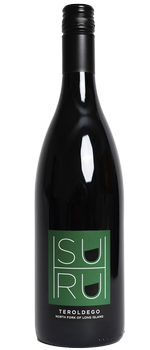 A perfect wine for the cooler Fall months, this unique red wine has warm baking spices on the nose with hints of anise, cinnamon, and red currant. Notes of red raspberry and wild briary fruit compliment the fine tannins and bright acidity on the finish making is a perfect wine to enjoy with a meal!
A perfect wine for the cooler Fall months, this unique red wine has warm baking spices on the nose with hints of anise, cinnamon, and red currant. Notes of red raspberry and wild briary fruit compliment the fine tannins and bright acidity on the finish making is a perfect wine to enjoy with a meal!
A Brief History of the Grape
Teroldego is a lesser known Northern Italian varietal (best known as the nephew of an old French variety that was the parent of Syrah) and is a rarity on the North Fork and in the US. To our knowledge there is only one vineyard on the East End with this grape variety planted and we are very excited to have gotten our hands on it!
Fun Fact: 97% of the world's Terolego’s production comes from Italy
Teroldego is found across the globe in California, Australia, New York and Brazil however the majority of the Teroldego vines planted are in Italy. An Italian red grape variety primarily found in the northeast region of Trentino-Alto Adige, it is believed that the name “Teroldego” came from the traditional method of cultivation in which the vines are trained on a system of “tirelle” or wire harnesses.
A cool-climate varietal, Teroldego is a hardy grape varietal that is known for being vigorous. It is best suited to permeable, well drained soils, making it a perfect grape to grow on Long Island where our soil is comprised of sandy loam soil with great drainage.
A Note from Winemaker Russell Hearn
 "Over the last 12 years Suhru has been committed to producing a small selection of wines, specifically selected to showcase the varieties that grow best in our region. Making a wine that you like is important, but it is more important to select a variety that grows well in the region otherwise as a winemaker I am setting myself up for failure, as you need great grapes to make a great wine.
"Over the last 12 years Suhru has been committed to producing a small selection of wines, specifically selected to showcase the varieties that grow best in our region. Making a wine that you like is important, but it is more important to select a variety that grows well in the region otherwise as a winemaker I am setting myself up for failure, as you need great grapes to make a great wine.
As my wine preferences have evolved over the decades I’ve found myself leaning towards elegant, over powerful red wines as they compliment rather than overwhelm the meal. This led me to further exploration of Italian wines, specifically wines from the Northern Alto Adige Region, where I happened upon Teroldego.
This variety is known for fruit forward, expressive wines with elegant tannin structure. Teroldgeo does not benefit from extended barrel aging, so can be bottled and released earlier than most of our other red wines and is an early ripener which is a huge asset in our region where hurricanes have been known to decimate later harvesting varieties. For all these reasons and more, when we discovered Teroldego planted on the North Fork we jumped on it and are very excited to share our latest wine. I hope you enjoy it as much as I do!”
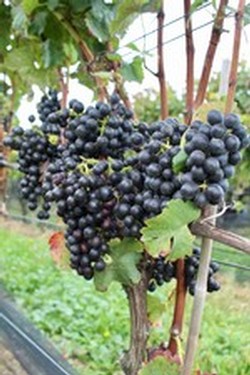 A Closer Look at Suhru Teroldego
A Closer Look at Suhru Teroldego
Grown in Southold, NY, Teroldego is known for being an early ripening (on the North Fork, Teroldego is usually picked around the second week of October, before Merlot) and early release wine. A light/medium bodied wine and a distant cousin if Syrah, Teroldego is designed to be enjoyed now and is not a wine that benefits from bottle aging.
After bring picked in early October, our Teroldego is fermented in open top tanks and then spends 9 months aging in French oak.
An extremely food-friendly wine, Teroldego pairs beautifully with a wide range of dishes including duck, swordfish, salmon, and gamey poultry. For more adventurous pairings try a bottle with teriyaki salmon, apple pie, walnut goat cheese pear salad, or brisket!
History of a Grape: Pinot Grigio vs Pinot Gris
Take a closer look at the history of of the grape as we examine Pinot Grigio! Dive into the differences between the Italian style Pinot Grigio and French style Pinot Gris to learn more about the history of Pinot Grigio vs Pinot Gris!
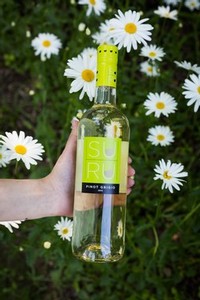 A Brief History of the Grape
A Brief History of the Grape
Pinot Grigio and Pinot Gris are genetically identical, these two styles of wine are made from the same grayish purple-hued grape. Identical twins with different personalities, the two styles each harken back to a national style.
Fun Fact: Pinot Grigio is a white variant-clone of the red grape Pinot Noir. Its skin is not green like other white grapes but is grayish, purple hued in color in pinecone shaped clusters.
The varietal itself originated in the Alsace region of France, from there it found its way to Switzerland in the 1300's and eventually made its way to Northern Italy, where it found wide acceptance in the wine world. As with many varieties (think Shiraz vs Syrah) the same grape varieties are often made in different styles based on the geographic region in which the wine is made and it is these differences that are at the root of the difference in style. In France, it is referred to as Pinot Gris, while in Italy it is called Pinot Grigio. At Suhru we focus on the Italian style, striving to make bright, crisp, refreshing Pinot Grigios.
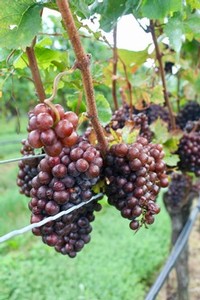 When made in the French style, Pinot Gris are generally speaking made from very ripe grapes which have had more sun exposure, resulting in lush, richer, fuller, flavors with soft acidity. These wines tend to be fuller-bodied, richer, barrel fermented with the intention to age, and often feature tropical fruits notes such as nectarine, melon, mango, and honeysuckle. Typically they are also finished with some residual sugar via stopping the fermentation prior to completion.
When made in the French style, Pinot Gris are generally speaking made from very ripe grapes which have had more sun exposure, resulting in lush, richer, fuller, flavors with soft acidity. These wines tend to be fuller-bodied, richer, barrel fermented with the intention to age, and often feature tropical fruits notes such as nectarine, melon, mango, and honeysuckle. Typically they are also finished with some residual sugar via stopping the fermentation prior to completion.
Pinot Grigio on the other hand are made with the intention of being consumed and enjoyed within 1-2 years. Light in body and often fermented completely dry, Pinot Grigios lean towards bright, crisp, dry flavors and are usually unoaked which accentuates the bright, crisp zesty flavors of the grape. Whereas with Pinot Gris you are looking for extended sun exposure to create a lush, rich wine when you are making a Pinot Grigio the key factor is acidity. As the grape ripens in the vineyard you are watching the acidity levels. As soon as the acidity starts to drop you know it is time to pick because with this style you are looking for bright, crisp flavors which are enhanced by higher acidity levels in the wine. Common tasting notes for Italian style Pinot Grigios include granny smith apple, meyer lemon, and lime zest. When describing Pinot Grigio our benchmark are the Northern regions of Italy Venezio and Alto Adige not the warmer regions where this variety becomes a little blander in description due to too much heat.
 A Closer Look at Suhru Pinot Grigio
A Closer Look at Suhru Pinot Grigio
Pinot Grigio was one of the first white wines Sue fancied when she first became interested in wine. The wide variation in the Pinot Gris and Pinot Grigios found around the world struck her interest and has captivated her ever since!
This strong interest in the variety has led to trips to France where Sue and Russ toured the regions of Loire, Burgundy, Champagne, Alsace, Bordeaux, Languedoc, and Provence as well as trips to Italy where they spent time tasting their way through Tuscany, Piedmont, Alto Adige, Umbria,to name a few.
When first starting Suhru Wines and deciding on the varieties they would make, Sue knew that Pinot Grigio needed to be one of them. Being based on the North Fork of Long Island, our cool maritime climate offers ideal conditions for this variety as our long hot summers and cool fall nights create an ideal environment to grow the variety.
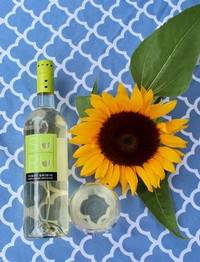 Suhru Pinot Grigio Tasting Notes
Suhru Pinot Grigio Tasting Notes
Our signature wine, the Suhru Pinot Grigio—made in both bottles and cans—is the first wine we chose to make when starting Suhru Wines. Pale straw yellow with an earthy aroma and hints of lemon zest on the nose, the Suhru Pinot Grigio has notes of granny smith apple and bosc pear.
Made entirely of Pinot Grigio fruit, this white wine was fermented and aged entirely in stainless steel tanks, resulting in a finished wine that accentuates the vibrant varietal fruit aromas and flavor while retaining a clean, crisp acidity that compliments the refreshing finish.
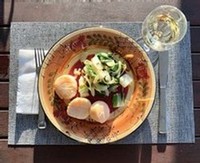 Recommended Food Pairings:
Recommended Food Pairings:
The crisp, bright flavors and refreshing acidity of our Pinot Grigio compliments a diverse range of foods. Try a glass of this Pinot Grigio with lighter flavors such as fish, salads, chicken, cheese, or a meatier fish like swordfish.
Some of our favorite pairings include: creamy cheeses like Brie or Camenbert, richers seafood dishes like lobster, scallops, or salmon, and Parmesan focused pasta dishes!Whatever you choose, the bright crisp finish makes this an excellent pairing wine, happy sipping!
History of the Bottle
 People have been making wine for millennium, with the first evidence of winemaking dating back to sometime between 8000 B.C. and 4100 B.C. However since the beginning the challenge has always been how to store the wine once it was made.
People have been making wine for millennium, with the first evidence of winemaking dating back to sometime between 8000 B.C. and 4100 B.C. However since the beginning the challenge has always been how to store the wine once it was made.
Glass bottles were not used in wine on a large scale until the 17th century, although they were different shapes—squat, with large bases and short necks—than the wine bottles today. It wasn’t until the 1820s that glass wine bottles began to resemble the ones we use today.
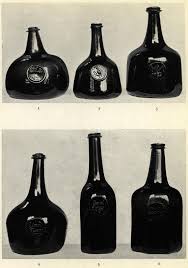 The main reason for the delay in the adoption of glass bottles for wine storage was that for centuries it was illegal to sell wine in a bottle. There were so many different bottle types (and volume variations) that it was far too easy to cheat, so merchants measured out wine from their barrels into containers that customers supplied themselves to ensure accurance.
The main reason for the delay in the adoption of glass bottles for wine storage was that for centuries it was illegal to sell wine in a bottle. There were so many different bottle types (and volume variations) that it was far too easy to cheat, so merchants measured out wine from their barrels into containers that customers supplied themselves to ensure accurance.
In the 17th century that all changed. Up until the 17th century glass bottles were considered a luxury item due to the fact that they were made to order and handcrafted in a wood or charcoal furnace. Bottles were a time consuming product to make and therefore very expensive. However in 1615, King James I decided that English forests were better used to make warships. Wood was in short supply so manufacturers turned to coal, which burned hotter and produced stronger glass.
 Sir Kenelm Digby is cited as “the father of the modern bottle” for discovering a process that resulted in stronger bottles that were able to be made and distributed on a wider scale. A controversial adventurer, privateer and alchemist Sir Digby was known for turning sand into gold by adding some secret ingredients (metals and oxides) and using a blower system to get the fire even hotter. His new formula produced glass bottles that were stronger, thicker, darker—and cheaper thus bringing a stronger better suited glass bottle to market.
Sir Kenelm Digby is cited as “the father of the modern bottle” for discovering a process that resulted in stronger bottles that were able to be made and distributed on a wider scale. A controversial adventurer, privateer and alchemist Sir Digby was known for turning sand into gold by adding some secret ingredients (metals and oxides) and using a blower system to get the fire even hotter. His new formula produced glass bottles that were stronger, thicker, darker—and cheaper thus bringing a stronger better suited glass bottle to market.
This discovery made glass more widely available, but it wasn’t until the 1900s that mass production began. In 1887, an English company created a semi-automatic machine that could produce up to 200 bottles an hour. Over the years this process has been pefected and refined to allow modern machines to produce more than 600 containers per minute.
Everything You've Ever Wanted to Know About Decanting
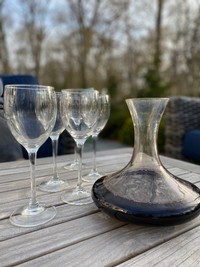
Did you know? Decanting red wine separates the wine from any sediment in the bottle. Decanted wines often taste softer, because the act of decanting adds oxygen to the wine softening the tannins in the wine.
What is decanting?
Decanting is simply the process of pouring (decanting) the wine from one container (usually a bottle) into another, the decanter. The wine is often then served directly into the glass from the decanter itself.
Why decant wine?
This process is not necessary with every wine, but is usually reserved with older, heavier wines (think our T'Jara Cabernet Franc and Petit Verdot). Aged, heavier red wines often have sediment at the bottom of the bottle, which if disturbed can end up in your glass. The process of decanting separates the wine from the sediment, making for a more enjoyable drinking experience. The sediment itself, is harmless to drink but can make the wine taste more astringent and will often give the wine a gritty mouth feel.
Another reason to decant is to aerate the wine. This is generally most beneficial to younger wines that may taste a little "tight" when first opening, as well as highly tannic and full-bodied wines. This is often why people talk about opening a wine to let it "breathe;" decanting or aerating the wine speeds up this process, ensure the wine is ready to drink when you are. Swirling your wine in the glass is another way to aerate your wine.
How do I decant?
To decant a wine, you will need a bottle of wine, a small flashlight (or the flashlight on your smart phone), and a decanter (this can be any 750ml or larger vessel). Prior to decanting your wine, let the wine rest upright in the bottle for an hour or so to let the sediment settle to the bottom of the bottle. Then, with your flashlight in hand, slowly pour the contents of the bottle into your decanter. Once about half of the bottle's contents have been poured into the decanter, place the flashlight under the neck of the bottle to illuminate the stream of wine so you can better see the sediment. Once you start to see a cloudy haze in the wine, stop pouring the wine into the decanter.
You will usually have about a glass of wine remaining, so to ensure that you can enjoy every last drop of this very nice wine you have just decanted, pour the remaining wine from the bottle into a glass or Champagne flute. This will allow any remaining sediment to once again settle to the bottom of the glass. Once the wine has settled, you can repeat the process and pour the clear wine off the remaining sediment.
